We were mired in a wealth of technical difficulties on Friday, beloved patrons (it’s been a frustrating month for technology, but we hope that it’s all under control at last), and as a result, we missed our regular Five Book Friday post, for which, a whole wheelbarrow-full of apologies. As a way to make it up to you, we are bringing you a heaping Six Book Sunday, featuring some of the newest books to shuffle up onto our shelves this week, including a snazzy extra book for your reading pleasure!

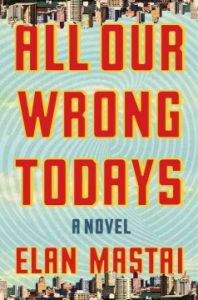 All Our Wrong Todays: One of the most anticipated releases of the year, Elan Mastai’s novel of life, love, and time travel somehow manages to live up to all its hype, delivering a story that is unexpectedly funny and stunningly touching. In Tom Barren’s version of 2016, technology has progressed, war is an outdated concept, and everyone lives a life of well-regulated hedonism. But Tom Barren’s world has never been one into which he fit. Then a bizarre time-traveling mishap launches Tom into our 2016. It all seems like some kind of dystopian nightmare at first, but then Tom meets this world’s version of his family and acquaintances, and realizes that this messy, dirty, nasty world of ours might be worth much more than he first thought. What makes this book so incredible is how Mastai blends complex science with simple, earnest, heartfelt story-telling to make a book that is high-concept, but utterly accessible. RT Book Reviews gave his work a Top Pick rating, saying, “With humor, grace and dizzying skill, Mastai crafts a time-traveling novel that challenges every convention of the trope, and succeeds brilliantly. His droll, unassuming writing style couches a number of razor-sharp critiques…while the endless array of technological gadgets, innovations and possibilities give the story its drive and irresistible exuberance… heartrending, funny, smart, and stunningly, almost brazenly hopeful.”
All Our Wrong Todays: One of the most anticipated releases of the year, Elan Mastai’s novel of life, love, and time travel somehow manages to live up to all its hype, delivering a story that is unexpectedly funny and stunningly touching. In Tom Barren’s version of 2016, technology has progressed, war is an outdated concept, and everyone lives a life of well-regulated hedonism. But Tom Barren’s world has never been one into which he fit. Then a bizarre time-traveling mishap launches Tom into our 2016. It all seems like some kind of dystopian nightmare at first, but then Tom meets this world’s version of his family and acquaintances, and realizes that this messy, dirty, nasty world of ours might be worth much more than he first thought. What makes this book so incredible is how Mastai blends complex science with simple, earnest, heartfelt story-telling to make a book that is high-concept, but utterly accessible. RT Book Reviews gave his work a Top Pick rating, saying, “With humor, grace and dizzying skill, Mastai crafts a time-traveling novel that challenges every convention of the trope, and succeeds brilliantly. His droll, unassuming writing style couches a number of razor-sharp critiques…while the endless array of technological gadgets, innovations and possibilities give the story its drive and irresistible exuberance… heartrending, funny, smart, and stunningly, almost brazenly hopeful.”
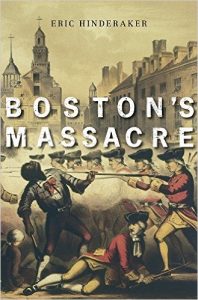 Boston’s Massacre: Perfectly timed to coincide with the 247th anniversary of the Boston Massacre, Eric Hinderaker’s book offers a new take on this seminal event in the run-up to the American War of Independence. On the night of March 5, 1770, British soldiers fired into a crowd gathered in front of Boston’s Custom House, killing five people–yet for all that we reference the event, very little about the “Boston Massacre” is known for a fact. In this thoroughly-researched and illuminating work, Professor Hinderaker takes on the multiple competing narratives that emerged from the ‘massacre’, and draws connections between this event and more modern examples of police brutality, showing that the Boston Massacre still has some significance today. As Publisher’s Weekly notes, “Hinderaker claims no definitive version of the event, instead offering a thoughtful meditation on the episode’s significance for shared American identity and memory. Untangling the complex circumstances under which Britain stationed thousands of troops in Boston in the peacetime of 1768…He ends with a provocative…reflection on the massacre’s symbolic resonance with more recent examples of police brutality, making this book important reading for anyone interested in questions regarding the limits of authority and protest.”
Boston’s Massacre: Perfectly timed to coincide with the 247th anniversary of the Boston Massacre, Eric Hinderaker’s book offers a new take on this seminal event in the run-up to the American War of Independence. On the night of March 5, 1770, British soldiers fired into a crowd gathered in front of Boston’s Custom House, killing five people–yet for all that we reference the event, very little about the “Boston Massacre” is known for a fact. In this thoroughly-researched and illuminating work, Professor Hinderaker takes on the multiple competing narratives that emerged from the ‘massacre’, and draws connections between this event and more modern examples of police brutality, showing that the Boston Massacre still has some significance today. As Publisher’s Weekly notes, “Hinderaker claims no definitive version of the event, instead offering a thoughtful meditation on the episode’s significance for shared American identity and memory. Untangling the complex circumstances under which Britain stationed thousands of troops in Boston in the peacetime of 1768…He ends with a provocative…reflection on the massacre’s symbolic resonance with more recent examples of police brutality, making this book important reading for anyone interested in questions regarding the limits of authority and protest.”
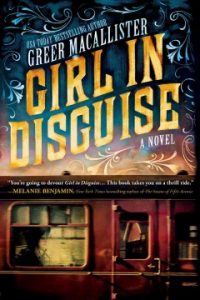 Girl in Disguise: Even though I’ve publicly stated that I will no longer tolerate another novel with “girl” in the title, Greer Macallister’s historic mystery is good enough to make me want to bend the rules. With no money and no husband, Kate Warne finds herself with few choices. The streets of 1856 Chicago offer a desperate widow mostly trouble and ruin–unless that widow has a knack for manipulation and an unusually quick mind. In a bold move that no other woman has tried, Kate convinces the legendary Allan Pinkerton to hire her as a detective. Faced with fighting criminals and coworkers alike, Kate immerses herself in the dangerous life of an operative, winning the right to tackle some of the agency’s toughest investigations, even at the risk to her own life and spirit. Based on the adventures of real-life detective Kate Warne, Macallister has crafted a action-packed thrill-ride through 1850’s America that Booklist called “a rip-roaring, fast-paced treat to read, with compelling characters, twisted villains, and mounds of historical details adeptly woven into the tale of a courageous woman who loves her job more than anything or anyone else.”
Girl in Disguise: Even though I’ve publicly stated that I will no longer tolerate another novel with “girl” in the title, Greer Macallister’s historic mystery is good enough to make me want to bend the rules. With no money and no husband, Kate Warne finds herself with few choices. The streets of 1856 Chicago offer a desperate widow mostly trouble and ruin–unless that widow has a knack for manipulation and an unusually quick mind. In a bold move that no other woman has tried, Kate convinces the legendary Allan Pinkerton to hire her as a detective. Faced with fighting criminals and coworkers alike, Kate immerses herself in the dangerous life of an operative, winning the right to tackle some of the agency’s toughest investigations, even at the risk to her own life and spirit. Based on the adventures of real-life detective Kate Warne, Macallister has crafted a action-packed thrill-ride through 1850’s America that Booklist called “a rip-roaring, fast-paced treat to read, with compelling characters, twisted villains, and mounds of historical details adeptly woven into the tale of a courageous woman who loves her job more than anything or anyone else.”
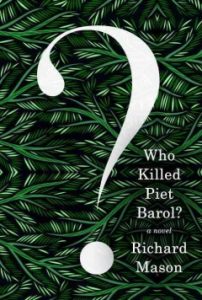 Who Killed Piet Barol?: Keeping within the realms of historic fiction, we have Richard Mason’s second book featuring Piet Barol (the first being History of a Pleasure Seeker), here, it is 1914, and Piet is living large in South Africa’s Cape Colony, pursuing his constant hunger for riches and comfort, even as imperial official ruthlessly turn native inhabitants out of their homes in an attempt to create a land of white settlers. However, Piet’s prodigious luck is about to run out. Reinventing himself once again as a furniture dealer–but the wood he needs is in a forbidden forest filled with sacred, untouchable trees. His pursuit of the bewitched trees of the fabled forest of Gwadana takes him deep into the Xhosa homelands, where unfailing charm, wit and the friendship of two black men are his only allies as he attempts an act of supreme audacity: to steal a forest from its rightful owners. Mason always does a superb job of crafting a setting, and the portrait he paints of the violent and fascinating Cape Colony is one of his finest. But more than that, this narrative–a bizarre blend of fact, fable, horror and hilarity, is one that is hard to put down or forget. Library Journal loved this book, remarking on its “Eloquent, sensuous prose . . . Mason imbues the forest with life, taking readers inside the psyche of each tree, animal, or insect, as it senses the looming danger . . . Vivid . . . This profoundly tragic tale, in which colonialism battles tribal customs, and divisions of race and class sow distrust, should put Mason over the top.”
Who Killed Piet Barol?: Keeping within the realms of historic fiction, we have Richard Mason’s second book featuring Piet Barol (the first being History of a Pleasure Seeker), here, it is 1914, and Piet is living large in South Africa’s Cape Colony, pursuing his constant hunger for riches and comfort, even as imperial official ruthlessly turn native inhabitants out of their homes in an attempt to create a land of white settlers. However, Piet’s prodigious luck is about to run out. Reinventing himself once again as a furniture dealer–but the wood he needs is in a forbidden forest filled with sacred, untouchable trees. His pursuit of the bewitched trees of the fabled forest of Gwadana takes him deep into the Xhosa homelands, where unfailing charm, wit and the friendship of two black men are his only allies as he attempts an act of supreme audacity: to steal a forest from its rightful owners. Mason always does a superb job of crafting a setting, and the portrait he paints of the violent and fascinating Cape Colony is one of his finest. But more than that, this narrative–a bizarre blend of fact, fable, horror and hilarity, is one that is hard to put down or forget. Library Journal loved this book, remarking on its “Eloquent, sensuous prose . . . Mason imbues the forest with life, taking readers inside the psyche of each tree, animal, or insect, as it senses the looming danger . . . Vivid . . . This profoundly tragic tale, in which colonialism battles tribal customs, and divisions of race and class sow distrust, should put Mason over the top.”
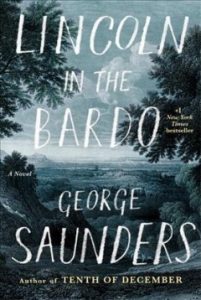 Lincoln in the Bardo: Quite seriously, it’s only March, and George Saunders’ first full-length novel may be the biggest, most acclaimed book of the entire year. After Lincoln’s beloved son, Willie, dies the president is bereft. Newspapers report that a grief-stricken Lincoln returns, alone, to the crypt several times to hold his boy s body. From that seed of historical truth, George Saunders spins an unforgettable story of familial love and loss that breaks free of its realistic, historical framework into a supernatural realm both hilarious and terrifying. Willie Lincoln finds himself in a strange purgatory where ghosts mingle, gripe, commiserate, quarrel, and enact bizarre acts of penance. Within this transitional state called, in the Tibetan tradition, the bardo a monumental struggle erupts over young Willie’s soul. On one level, this is a novel about monumental loss–not only Lincoln’s son, but the thousands and thousands of sons who were killed in the Civil War, and the optimism of a nation that very nearly tore itself apart. On the other, it is a stunning, whimsical, haunting story about life and living, that features an astounding number of individual voices, viewpoints, and truths. For those who like audiobooks, Saunders gathered over 100 narrators for this book, making it one of the most impressive productions of the year, as well. It’s hard to choose one good review out of the countless numbers that are rolling in, but we’ll go with Kirkus’ review here, which called this book “Exhilarating . . . Ruthless and relentless in its evocation not only of Lincoln and his quandary, but also of the tenuous existential state shared by all of us.”
Lincoln in the Bardo: Quite seriously, it’s only March, and George Saunders’ first full-length novel may be the biggest, most acclaimed book of the entire year. After Lincoln’s beloved son, Willie, dies the president is bereft. Newspapers report that a grief-stricken Lincoln returns, alone, to the crypt several times to hold his boy s body. From that seed of historical truth, George Saunders spins an unforgettable story of familial love and loss that breaks free of its realistic, historical framework into a supernatural realm both hilarious and terrifying. Willie Lincoln finds himself in a strange purgatory where ghosts mingle, gripe, commiserate, quarrel, and enact bizarre acts of penance. Within this transitional state called, in the Tibetan tradition, the bardo a monumental struggle erupts over young Willie’s soul. On one level, this is a novel about monumental loss–not only Lincoln’s son, but the thousands and thousands of sons who were killed in the Civil War, and the optimism of a nation that very nearly tore itself apart. On the other, it is a stunning, whimsical, haunting story about life and living, that features an astounding number of individual voices, viewpoints, and truths. For those who like audiobooks, Saunders gathered over 100 narrators for this book, making it one of the most impressive productions of the year, as well. It’s hard to choose one good review out of the countless numbers that are rolling in, but we’ll go with Kirkus’ review here, which called this book “Exhilarating . . . Ruthless and relentless in its evocation not only of Lincoln and his quandary, but also of the tenuous existential state shared by all of us.”
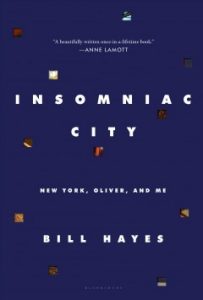 Insomniac City: New York, Oliver, and Me: Oliver Sacks died of cancer in August of 2015, leaving behind a fascinating body of work focused on the brain, its vagaries, and the way it made us uniquely–sometimes bizarrely–human, a number of touching books and memoirs…and Bill Hayes, a photographer who came to New York in 2009 after the death of his partner, and fell in love with the city at night, with the people who inhabited it, and, especially, with his neighbor, Sacks. This book of vignettes of Hayes’ memories of Sacks, and their shared love of New York City, including a number of Hayes startlingly honest, utterly captivating photos, offers a touchingly intimate view of a man that so many felt they knew from his books, from his falling in love for the first time at the age of 75 to his death. While a heart-rending tale of loss, it is also a beautiful meditation on the moments that make life worth living, and the kind of love that comes along once in a lifetime. Newsweek summed it up beautifully, saying “Buy a box of tissues and pray for snow: This…will have you alternately bawling and giddily clapping your hands for the lovers that may not have had the time they deserved, but certainly made the best with the time that they had.”
Insomniac City: New York, Oliver, and Me: Oliver Sacks died of cancer in August of 2015, leaving behind a fascinating body of work focused on the brain, its vagaries, and the way it made us uniquely–sometimes bizarrely–human, a number of touching books and memoirs…and Bill Hayes, a photographer who came to New York in 2009 after the death of his partner, and fell in love with the city at night, with the people who inhabited it, and, especially, with his neighbor, Sacks. This book of vignettes of Hayes’ memories of Sacks, and their shared love of New York City, including a number of Hayes startlingly honest, utterly captivating photos, offers a touchingly intimate view of a man that so many felt they knew from his books, from his falling in love for the first time at the age of 75 to his death. While a heart-rending tale of loss, it is also a beautiful meditation on the moments that make life worth living, and the kind of love that comes along once in a lifetime. Newsweek summed it up beautifully, saying “Buy a box of tissues and pray for snow: This…will have you alternately bawling and giddily clapping your hands for the lovers that may not have had the time they deserved, but certainly made the best with the time that they had.”
Until later, beloved patrons–happy reading!
